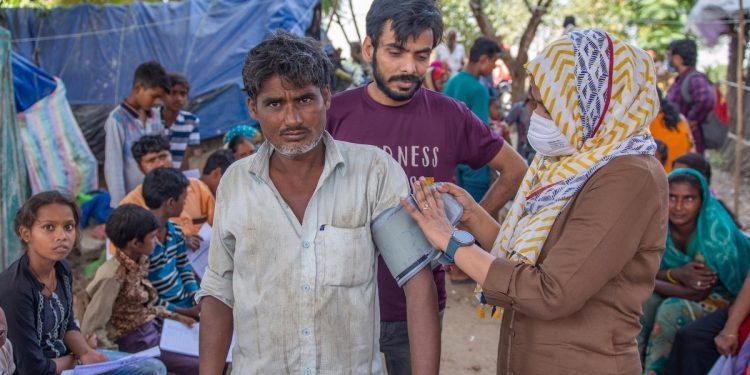Overview
In most cases, it is tooth decay (caries), periodontitis, tooth loss, and oral cancer.
Moreover, the WHO World Oral Health Report (2022) estimates that oral diseases affect almost 3.5 billion people worldwide, with three out of four affected people living in middle-income countries. Moreover around the world, approximately 2 billion people suffer from tooth decay in their permanent teeth and 514 million children suffer from tooth decay in their baby teeth.
Moreover, with increasing urbanization and changing living conditions, the incidence of serious oral diseases continues to increase worldwide. This is largely due to inadequate levels of fluoride (in drinking water and in oral care products such as toothpaste), the availability and affordability of high-sugar foods, and poor access to community oral hygiene. The marketing of high-sugar foods and beverages, as well as tobacco and alcohol, has led to an increase in the consumption of
products that contribute to oral and other non-communicable diseases.
Dental caries (tooth decay)
Tooth decay occurs when plaque builds up on the tooth surface and the free sugars contained in foods and beverages (any sugar added to foods by the manufacturer, cook or consumer the manufacturer, cook, or consumer, as well as sugars naturally present in honey, syrup, and fruit juices) converts into acids that destroy the tooth over time. Consistently high free sugar consumption, inadequate fluoride exposure, and failure to remove plaque with brushing can lead to tooth decay, pain, and sometimes tooth loss and infection.
Periodontal (gum) disease
Moreover, In the most severe form, gum tissue can separate from the tooth and supporting bone, causing the teeth to loosen and sometimes fall out. It is estimated that 19% of the world’s adult population is affected by severe periodontitis, representing more than 1 billion cases worldwide. The main risk factors for periodontitis are poor oral hygiene and smoking.
Edentulism (total tooth loss)
Tooth loss is usually the endpoint of enduring oral disease, particularly advanced caries, and severe periodontitis, but can also result from trauma and other causes. The estimated global average prevalence of complete tooth loss in people aged 20 years and older is almost 7%. A significantly higher overall prevalence of 23% was estimated for people aged 60 and over. Tooth loss can be psychologically traumatic, socially damaging, and functionally handicapped.
Oral Cancer
Oral cancer includes cancers of the lip, other parts of the mouth, and oropharynx, which together represent the 13th most common type of cancer worldwide. Oral cancer is more common in men and older people, is more deadly in men than women, and varies widely by socioeconomic condition.
Tobacco, alcohol, and areca nut (betel) consumption are among the leading causes of oral cancer. In North America and Europe, human papillomavirus infection is responsible for increased rates of oral cancer among young people.
Oro-dental trauma
Children aged 2 to 6 who are malnourished, suffer from infectious diseases, live in extreme poverty, have poor oral hygiene, or have a weakened immune system are particularly affected.
Noma
Noma begins with a change in the soft tissue (pain) of the gums. Acute necrotizing gingivitis then occurs, which progresses rapidly, destroying soft tissue and spreading to hard tissue and facial skin.
According to the latest estimates (since 1998) there are 140,000 new cases of noma each year. Moreover, without treatment, noma is fatal in 90% of cases. And then survivors suffer severe facial disfigurement, have difficulty speaking and eating, suffer from social stigma, and require complex surgeries and rehabilitation. If noma is caught at an early stage.
Cleft lip and palate
Orofacial clefts, the most common congenital craniofacial anomaly, occur with an incidence of 1 in 1,000 to 1,500 births worldwide. And then with large variations between studies and populations (1). The main reason is a genetic predisposition. But poor maternal nutrition, smoking, alcohol, and obesity during pregnancy also play a role. Infant mortality is high in low-income areas. With proper surgical treatment of a cleft lip and palate, full rehabilitation is possible.
Risk factors
Most oral diseases and conditions have modifiable risk factors such as smoking, alcohol consumption, and an unhealthy diet high in free sugars, which are also shared by the four major.
Oral health inequalities
There is a very strong and consistent association between socioeconomic status (income, occupation, and level of education). And the incidence and severity of oral disease. This association extends from infancy to old age and covers populations in high-, middle- and low-income countries.
These include
Moreover, promote a balanced diet low in simple sugars and high in fruit and vegetables. And prefer water as their main drink;
Stop consuming all types of tobacco, including chewed areca nuts.
limit alcohol consumption; AND, which encourages the use of protective devices in sports and when traveling by bicycle. And motorcycle (to reduce the risk of facial injuries).
Adequate exposure to fluoride is an important factor in preventing dental caries.
Recommend brushing twice daily with fluoride toothpaste (1000 to 1500 ppm).
Access to oral health services
Access to basic oral health services is often poor due to the unequal distribution of oral health professionals. And the lack of adequate health facilities to meet the needs of the population in most countries. Oral health care co-payments can be a major barrier to accessing medical care. Paying for basic oral health care is a leading cause of catastrophic healthcare spending. Leading to an increased risk of impoverishment and economic hardship.

